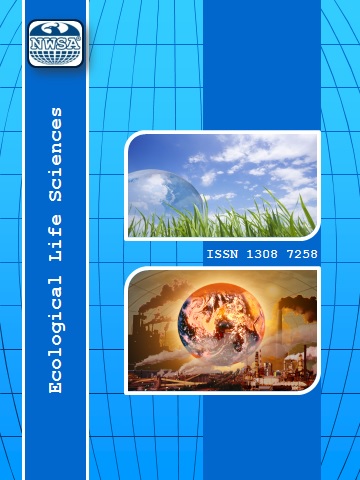References
[1] Boran, ?., (2017). Su ürünleri yeti?tiricili?i ve ekonomiye katkysy. ARGE Bülten, 2017 Kasym Aralyk-Sektörel, 24-30.
[2] Çavdar, Y., (2009). Su ürünleri yeti?tiricili?inde desteklemeler. SÜMAE Yunus Ara?tyrma Bülteni. 9(1):13-14.
[3] Alparslan, Y. ve Baygar, T., (2009). Levrek baly?ynyn Türkiye ve Dünyada yeri, önemi ve pazar durumu. ABMYO Dergisi, 13:31-40.
[4] TUYK, (2020). https://www.tuik.gov.tr/.
[5] FAO, (2020). http://ec.europa.eu/fisheries/publications/studies/aquaculture. (Eri?im Tarihi: 24.10.2008).
[6] Sa?lam, N., Gürel Ynanly, A., and Emir Çoban, Ö., (2021). Sectoral Analysis Report: Aquaculture and Fisheries.
[7] Sternisa, M., Mraz, J., and Smole Mozina, S., (2016). Microbiological aspects of common carp (Cyprinus carpio) and its processing-Relevance for final product quality: A review. Aquacult International, 24(6)156990.
[8] Rahmanifarah, K., Shabanpour, B., and Sattari, A., (2011). Effects of clove oil on behavior and flesh quality of common carp (Cyprinus carpio L.) in comparison with pre-slaughter CO2 stunning, chilling and asphyxia. Turkish Journal of Fisheries and Aquatic Sciences, 11:13947.
[9] Varga, D., Szabó, A., Hancz, C., Jeney, Z., Ardó, L., Molnár, M., et al., (2014). Impact of handling and pre-mortal stress on the flesh quality of common carp (Cyprinus carpio L.), Israeli Journal of Aquaculture-Bamidgeh, 66:16.
[10] Daskalova, A.H. and Pavlov, A.I., (2015). Effect of two stunning methods on postmortem muscle pH and meat quality of common carp (Cyprinus carpio). Bulgarian Journal of Veterinary Medicine, 18(1):8390.
[11] Richards, M.P. and Hultin, H.O., (2002). Contributions of blood and blood components to lipid oxidation in fish muscle. Journal of Agricultural and Food Chemistry, 50(3):555564.
[12] Sohn, J.H., Ushio, H., Ishida, N., Yamashita, M., Terayama, M., and Ohshima, T., (2007). Effect of bleeding treatment and perfusion of yellowtail on lipid oxidation in post-mortem muscle. Food Chemistry, 104(3):96270.
[13] Thiansilakul, Y., Benjakul, S., and Richards, M.P., (2011). Effect of myoglobin from Eastern little tuna muscle on lipid oxidation of washed Asian seabass mince at different pH conditions. Journal of Food Science, 76(2):C2429.
[14] Lee, S.K., Tatiyaborworntham, N., Grunwald, E.W., and Richards, M.P., (2015). Myoglobin and haemoglobin-mediated lipid oxidation in washed muscle: Observations on crosslinking, ferryl formation, porphyrin degradation, and haemin loss rate. Food Chemistry, 167:25863.
[15] Wandersman, C. and Delepelaire, P., (2004). Bacterial iron sources: From siderophores to hemophores. Annual Review of Microbiology, 58:61147.
[16] Maqsood, S., Benjakul, S., and Kamal-Eldin, A., (2012). Haemoglobin-mediated lipid oxidation in fish muscle: A review. Trends in Food Science and Technology, 28(1):3343.
[17] Sternisa, M., Dvorak, P., Lunda, R., Linhartova, Z., Smole Mozina, S., and Mraz, J., (2018). Bleeding of common carp (Cyprinus carpio) improves sensory quality of fillets and slows oxidative and microbiological changes during refrigerated aerobic storage. Food Technology and Biotechnology, 56(4):524532.
[18] Roth, B., Imsland, A., Gunnarsson, S., Foss, A., and Schelvis-Smith, R., (2009). Slaughter quality and rigor contraction in fanned turbot (Scophthalmus maximus): A comparison between different stunning methods. Aquaculture, 272:754761.
[19] Digre, H., Erikson, U., Misimi, E., Standal, I.B., Gallart-Jornet, L., Riebroy, S., and Rustad, T., (2011). Bleeding of farmed Atlantic cod: residual blood, color, and quality attributes of pre- and postrigor fillets as affected by perimortem stress and different bleeding methods. Journal of Aquatic Food Product Technology, 20:391-411.
[20] Roth, B., Torrissen, O.J., and Slinde, E., (2001). The effect of slaughtering procedures on bleeding in haematocrit on blood flow distribution. Journal of Experimental Biology, 179:115129.
[21] Erikson, U. and Misimi, E., (2008). Atlantic salmon skin and fillet colour changes effected by perimortem handling stress, rigor mortis, and ice storage. Journal of Food Science, 73:C509.
[22] Mishima, T., Nonaka, T., Okamoto, A., Tsuchimoto, M., Ishiya, T., Tachibana, K., and Tsuchimoto, M., (2015). Influence of storage temperatures and killing procedures on post-mortem changes in the muscle of horse mackerel caught near Nagasaki Prefecture, Japan. Fish Science Journal, 71:18794
 +90(535) 849 84 68
+90(535) 849 84 68 nwsa.akademi@hotmail.com
nwsa.akademi@hotmail.com Fırat Akademi Samsun-Türkiye
Fırat Akademi Samsun-Türkiye
